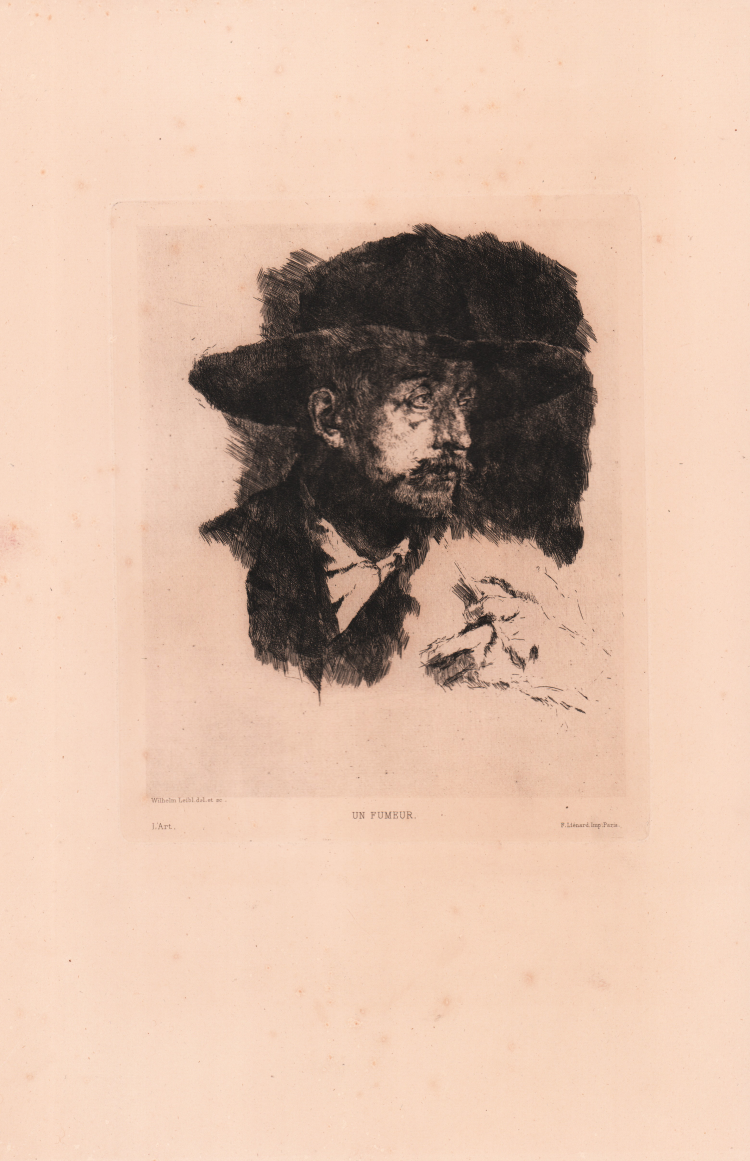


| Reference: | S46004 |
| Author | Wilhelm Maria Hubertus Leibl |
| Year: | 1874 ca. |
| Measures: | 185 x 230 mm |


| Reference: | S46004 |
| Author | Wilhelm Maria Hubertus Leibl |
| Year: | 1874 ca. |
| Measures: | 185 x 230 mm |
Portrait of the painter Eugen Horstig; wearing a large hat and holding a pipe in his left hand.
Etching, circa 1874. A second state, published in 'L'Art', 1891, volume 51.
A good impression on contemporary laid paper, with margins, very good condition.
Bibliografia
Billeter 1994 / Wilhelm Leibl zum 150. Geburtstag (3).
Wilhelm Maria Hubertus Leibl (Colonia 1844 - Würzburg 1900)
|
German painter. After studying at the Munich Academy, he felt the decisive influence of G. Courbet's painting, during the latter's stay in Munich (1869) and during a subsequent six-month stay in Paris. In contact with J. Sperl, H. Thoma, C. Schuch, K. Hagemeister, he was considered the leader of German realism but opposed by academic circles. Having retired, in 1873, to live in the Bavarian Prealps, he painted with a firm and clear spirit of observation, with a refined taste for color and for compact and limpid form. Among his works: Cocotte (1869, Cologne, Wallraf-Richartz Museum), which documents Courbet's immediate impression; Peasant Woman of Dachau (1874-75, Berlin, Stiftung Staatliche Museen); The Village Politicians (1871, Winterthur, Stiftung O. Reinhart); Three Women in Church (1882, Hamburg, Kunsthalle), numerous beautiful portraits (Countess Rosina von Treuberg, 1878, Hamburg, Kunsthalle). In 1892 he was appointed professor at the Royal Bavarian Academy.
|
Wilhelm Maria Hubertus Leibl (Colonia 1844 - Würzburg 1900)
|
German painter. After studying at the Munich Academy, he felt the decisive influence of G. Courbet's painting, during the latter's stay in Munich (1869) and during a subsequent six-month stay in Paris. In contact with J. Sperl, H. Thoma, C. Schuch, K. Hagemeister, he was considered the leader of German realism but opposed by academic circles. Having retired, in 1873, to live in the Bavarian Prealps, he painted with a firm and clear spirit of observation, with a refined taste for color and for compact and limpid form. Among his works: Cocotte (1869, Cologne, Wallraf-Richartz Museum), which documents Courbet's immediate impression; Peasant Woman of Dachau (1874-75, Berlin, Stiftung Staatliche Museen); The Village Politicians (1871, Winterthur, Stiftung O. Reinhart); Three Women in Church (1882, Hamburg, Kunsthalle), numerous beautiful portraits (Countess Rosina von Treuberg, 1878, Hamburg, Kunsthalle). In 1892 he was appointed professor at the Royal Bavarian Academy.
|